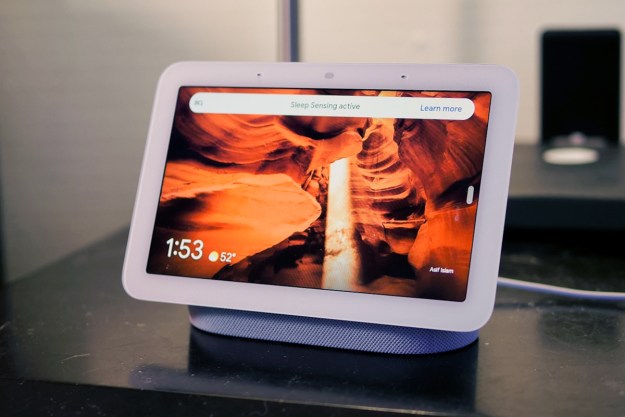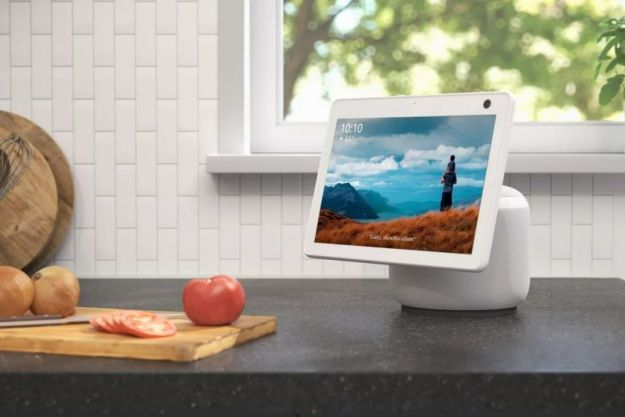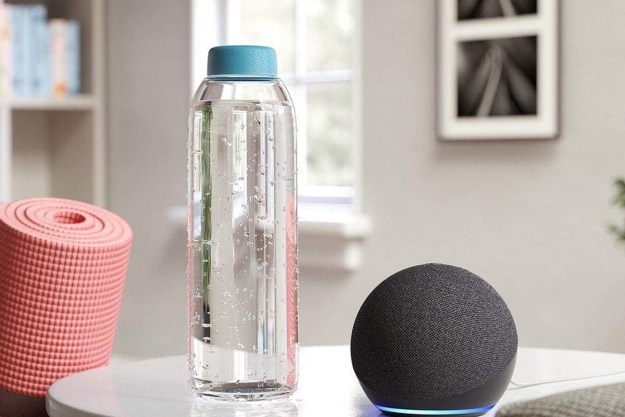
“The future promised us videophones, and the Nucleus intercom delivers.”
- Easy to use
- Lots of privacy settings
- Doesn’t take full advantage of its screen
- Microphone doesn’t work as well as the Dot or Echo
- Not fully hands free
When Amazon recently announced the Echo Show – a tablet-like video caller with Alexa integrated – the team behind the Nucleus Anywhere Intercom must have cringed. Their own tablet-like video caller with Alexa integrated has been around since 2016. Some saw it as a cautionary tale about partnering with Amazon: The retail giant just might make a big splash in the same pond you’re wading in. Amazon said it didn’t get the idea for its Show from Nucleus, and thinks the two devices are complimentary.
The Echo show isn’t out yet, but we spent a few weeks with the Nucleus in the meantime. The verdict? We’re not sure we want any always-on communication device with a camera in our bedroom.
Get the picture
Designed to either sit upright on a desk or hang from the wall, the Nucleus measures 8.1 by 6.9 by 1 inches (height, width, depth) and weighs a pound. It has speakers and a microphone, as well as a 5-megapixel, 120-degree wide-angle camera with manual-close privacy shutter. Its 1,280-by-800-pixel touchscreen spans 8 inches.
It’s also a sort of Skype replacement, letting users in different households video chat.
The stand that you use to prop up the device is removable, but it only fits in one position, so you can’t tilt it if you want it facing a different angle. The included brackets allow you to mount the Nucleus, but it will have to be near an outlet, and the cord will hang down.
To set it up, you plug it in and let it boot up, then add it to your Wi-Fi network using the touchscreen. To connect it to your phone, you create a Nucleus account and download the iOS or Android app. On your phone, you’ll get notifications when someone calls you, and you can also connect with your Nucleus devices. On the Nucleus, you type in your family name and the name of the rooms where the devices will live. We chose Kitchen and Boudoir. You can use the device’s camera to snap a photo of the room, too. Then it’s time to sync with your Amazon account to start utilizing Alexa. To set up more intercoms, you can use the “Home Code” the first device generates to make the process a little quicker.
The interface is pretty bare bones. The Home screen lists all your in-home devices, while the Remote tab shows you friends’ and family’s phone and video options. There are few settings along the bottom of the screen, like brightness and volume. We found that even the lowest brightness setting had too much glow in a dark bedroom, and resorted to putting it face down or turning it off at night. Not exactly ideal. We found the picture quality OK, but in low light people tended to turn into ghostly blobs.
You can also put the Nucleus in Do Not Disturb mode so no one can call and mute the microphone, so Alexa isn’t listening. The top-left menu has more settings, and it’s where you can connect to more Nucleus devices or add in family members’ phone numbers. If you get one for your parents, you’ll be able to connect, Nucleus to Nucleus, even if they live across the country.
Up and atom
The Nucleus’s main function is acting as an intercom, letting parents call kids down to dinner when they’re upstairs doing their homework. It’s also a sort of Skype replacement, letting users in different households video chat.
You can set the Nuclear to work in one of three different modes: Instant connects without someone picking up, Privacy means someone has to touch a button to answer the call, and Do Not Disturb means no calls at all can come through, and Alexa stops listening.
Amazon undoubtedly took the wind out of Nucleus’s sails with its announcement of the Echo Show.
If you have Instant activated and the privacy shutter isn’t in place, anyone can walk up to the Nucleus in the kitchen and instantly see what’s happening in the bedroom — with only a quick warning bloop sound to alert them. Privacy mode will thwart this, but then someone will also have to press a button to hear voice calls – that’s not how intercoms typically work.
It’s not a deal breaker, but we can see Instant with the shutter in place being one of the more convenient configurations. You can automatically connect like a regular intercom, without having to turn the camera to face the wall. How people use the Nucleus will probably depend on whether they have toddlers or teenagers at home. We can see parents becoming frustrating by not being able to override Do Not Disturb when it’s time to do the laundry or leave for soccer practice, though.
If you’re calling someone remotely — anyone who isn’t on your account — they will always have to accept the call, so you don’t surprise them unawares when you decide to say hello. You can keep family members who live in different homes on the same account, so you can still have the Instant mode on if you’re worried about an aging parent.
You can use Alexa’s Nucleus skill to “tell Nucleus” to make a call, so you don’t have to use the touchscreen, but you can’t ask
Echo, echo, echo
Having three Alexa-enabled devices in an 840-square-foot condo is terrible.
Amazon has an ESP feature for its own devices that keeps them from all responding at once, but Nucleus isn’t equipped. When we were in the bedroom, we had to whisper to the Nucleus to prevent the Dot in the living room from hearing. When we were in the living room, the kitchen Nucleus would often chime in.
The microphone in the Nucleus isn’t as good as the one in the Dot, either. We’d be listening to an audiobook; “Alexa, stop,” we’d say. “
Since Nucleus is a simple-to-use and family-focused device, it’s worth noting that Alexa devices, Amazon Prime, and young children don’t always mix. If there’s no passcode, they can end up ordering items and end up hearing some F-bomb-laden tunes on Amazon Music, as there’s no way to restrict music with explicit lyrics.
The Nucleus isn’t fully taking advantage of its screen yet. When we asked to see pictures of cats, it pulled up a card with a Wikipedia entry on cats and a single picture. When we asked to see pictures of Himalayan cats, no picture showed up. It also didn’t play videos of cats. When you ask for the weather, or convert units, it displays the answer on the screen, as well as reciting it.
It did show the text of a recipe it suggested for dinner from Allrecipes, but its drop-down menu with Play, Back, and Next buttons partially obscured the text, defeating the purpose. If we closed the menu, we couldn’t get Alexa to advance to the next step in the recipe — or to respond at all.
Nucleus also has potential to be useful around the smart home. Right now, Ring video doorbell users can link their accounts and see who’s at the door from the intercom.
Warranty
Nucleus offers a limited one-year warranty on the intercom.
Our Take
Amazon undoubtedly took the wind out of Nucleus’s sails with its announcement of the Echo Show. But even without that threat on the horizon, the Nucleus doesn’t yet do enough with its screen.
Is there a better alternative?
Right now, the only real smart speaker with a screen is the upcoming Echo Show, which will cost $229 to the Nucleus’ $149. As alternative, Google Home lets you get visual results with Chromecast on your TV, but that’s not quite the same as having a recipe on your kitchen counter.
How long will it last?
Only time will tell whether the Nucleus will stand up to Amazon’s Echo Show? Updates could help. If it pushed an update that showed us cooking tip videos while we were making a recipe or let us watch some kittens on command, it might be on its way to holding its own.
Should you buy it?
Probably not. Now priced at $149, the Nucleus is cheaper than the Echo Show, but sometimes frustrating to use. That said, it is a very straightforward device with versatile privacy features, which could make it worthwhile for some families. We can see it being a decent baby monitor that grows with your child, but unless you need one of these devices immediately, wait to see how the Echo Show performs.
Editors' Recommendations
- What to do if your Amazon Alexa app is not working
- Best Amazon Echo deals: Save on Pop, Show, Dot, and Studio
- Echo Hub vs. Echo Show 8: Which is the best option for your smart home?
- Can Alexa call 911? How to set up Alexa for emergencies
- The 6 best smart displays for Alexa and Google Home in 2024




